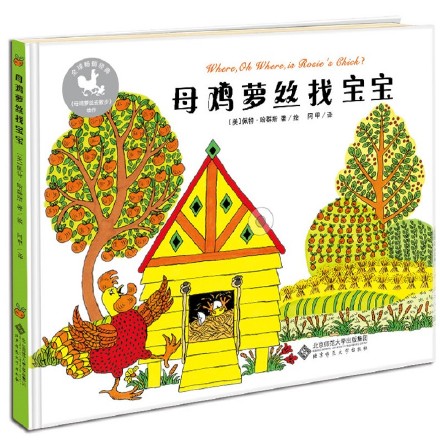When I heard that “Hen Rose Goes for a Walk” had a sequel, my first feeling was: Are you kidding? Because I happened to have traced the birth story of this classic picture book, which was published by Macmillan in the United States in 1968. The creator, British artist Pat Haggins, was only 26 years old at the time and temporarily lived in the United States. This was her first picture book when she debuted. At first, it may have been a hobby, but unexpectedly it became a hit and made her officially enter the children’s book industry. The naive, funny and unique hen Rose has gradually become a world-class picture book classic image, deeply loved by readers of all ages. Needless to say, countless researchers also love to study this book, using it as a classic example of picture book narrative methods to explain concepts such as “literary
× Picture = Picture Book” is a unique concept.
Pat Hagens has since written more than 40 children’s books, most of which are picture books, as well as several children’s novels. In 1974, he was also awarded the Best Picture for The Wind Blows.
Blew, winner of the Kate Greenaway Medal, the highest award for picture books in the UK, is a truly renowned writer. Years have passed, and there’s been no sign of a “Hen Rose sequel.” Now in her seventies, she no longer needs to write a sequel to her bestseller to make a living, let alone risk her reputation. Everyone knows that writing a sequel inevitably risks botching the original. But nearly half a century later, she’s pulling off another “Hen Rose” stunt. Isn’t that incredible?
But when I saw the sequel, Where, Oh Where is Rosie’s
Chick?), I couldn’t help but be impressed. This Grandma Hagens is still as charming as ever, and the lovely hen Rose is really here again!
It’s the same farm, the same slightly clueless hen, Rose, and the same sassy fox, but now there’s a new protagonist: a newly hatched chick! In this sequel, Rose is a loving mother hen, but a little anxious and overly worried. She can’t find her chicks. She searches under the coop, in a large basket of wood, behind a wheelbarrow, in the fields, and even in a haystack, but she can’t find them. Finally, unable to contain herself, she cries out, “Oh, little chick, where are you?” At that moment, the animals in the book, and the readers outside, will probably burst out in despair: The chicks are clearly right there!
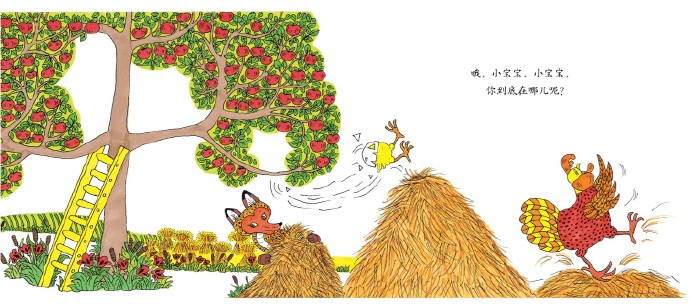
Illustration of “Hen Rose Looking for Her Babies”
And what was the fox doing all this time? He seemed to be stalking Rose the hen, always waiting for an opportunity to strike, either at Rose or perhaps at the chicks. But this time, he seemed to have learned his lesson and was very cautious, following at a distance, so nothing bad happened. Finally, the fox got very close to the chicks, and we couldn’t help but cry out in danger. Then, unexpectedly, a baby fox emerged from the haystack, much to the fox’s delight—it turned out the fox and the other fox were playing hide-and-seek!
Now that Haggins has become a grandmother, she seems even more compassionate. Not only did she keep Rose the hen and her chicks safe, but she also kept the fox and his chicks unharmed, innocently playing games. The first time I read this story, it felt a little underwhelming, because the unlucky fox was the real kicker. Children and adults alike love unlucky characters in stories. But don’t worry, read it again from the beginning, and you’ll see there are two unlucky characters in the illustrated story: a cat trying to pounce on the chicks at the henhouse. Thanks to the unintentional “collaboration” of Rose the hen and her chicks, the cat gets trapped under the door. The other is a large fish in the pond trying to bite the chicks. A piece of wood that Rose accidentally overturns creates a floating bridge for the chicks, and an apple she kicks from her wheelbarrow just happens to fill the fish’s mouth! This is sure to delight even the most discerning reader.
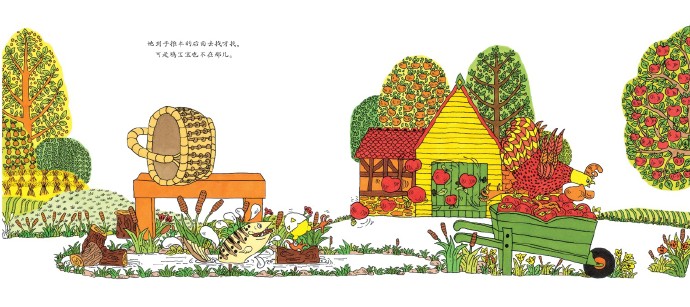
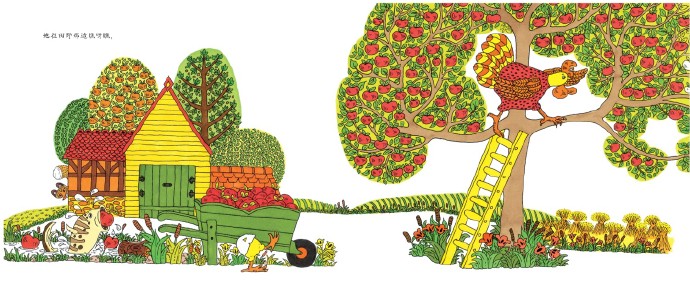
Illustration of “Hen Rose Looking for Her Babies”
However, for enthusiasts and researchers, this sequel also offers some welcome changes. Take, for example, the rhythm of the story. “Hen Rose Goes for a Walk” generally follows a two-beat rhythm: in one double-page spread, a fox pounces on a hen, and in the next, a rake springs up and hits the fox. In one spread, the fox pounces on a hen by the pond, and in the next, the fox falls into the pond… But in the sequel, this rhythm shifts to three-beat: in the first double-page spread, Rose screams for her chicks, while a kitten crouches at the entrance to the henhouse to peer. In the second, Rose lifts the door of the henhouse to search underneath, and a chick steps out, with the kitten poised to pounce. In the third, Rose turns to the basket, but the door falls down, crushing the kitten, and the chick lands safely. The scene of the big fish’s misfortune is also captured in a similar three-page spread. Unlike the original story, the scene transitions in the sequel are continuous, one interlocking with the next, and there’s a clear interactive relationship between the various farm animals. From the very beginning, all animals participate, whether helping to find the chicks or trying to catch them. If you take a closer look, you will find that this farm is really thriving.
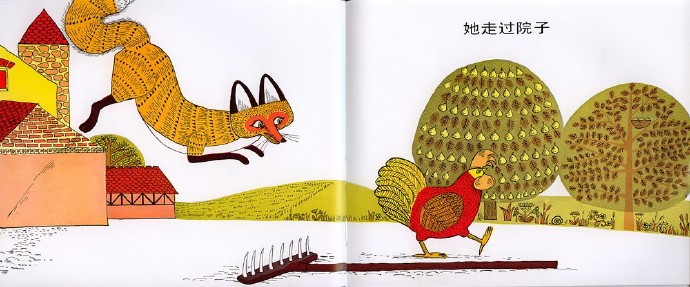
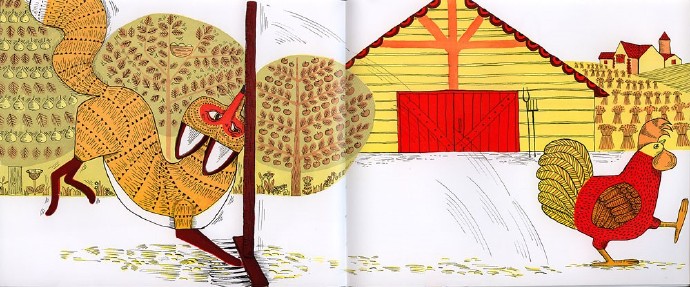
Comparative Illustration: Narrative Rhythm in “Hen Rose Goes for a Walk”
Another striking change is the color palette. The sequel’s colors are noticeably richer, with the browns and greens, in particular, becoming more vibrant than before. The farm and animals appear more vibrant overall. Why is this? In a recent interview, Pat Haggins explained that when she wrote the original story, due to production and printing costs, her editor asked her to use only red, yellow, and black. She then used these three colors, ink pen, to create illustrations in a woodcut-style. (To us readers, that creates a uniquely unadorned beauty.) Now, with no such restrictions, and her love for color, she has tried to incorporate every color she likes, though she abandoned blue because she found it unsuitable for the story. Overall, the new story better aligns with her vision of the farm’s colors. She grew up in the rural countryside of northern England, and her love of the countryside remains undiminished.
To the great relief of all readers who have waited 47 years, Grandma Haggins actually picks up the original story at the end of the sequel. We read, “Rose the hen and her chicks went for a walk…” As they strutted across the farm, the fox and its chicks peeked out from over a small hill, their eyes fixed on Rose and the chicks. This time, it wasn’t hide-and-seek. Turning to the next page, Rose and the chicks walked past a beehive, and bees flew out, heading for the foxes…
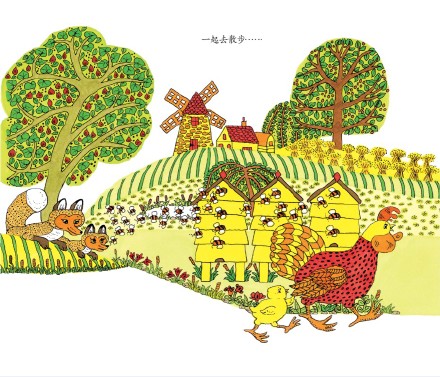
Illustration of “Hen Rose Looking for Her Babies”
I’m sure Rose fans are already eager to get their hands on this book, but I’d also like to draw your attention to the dedication page: “To Susan, who hatched Rose; to Anne, who hatched Rose’s chicks.” Who is Susan? Who is Anne? What’s the story behind this?
It turns out that Susan and Anne were two editors. Their story dates back to the 1960s in the United States. Susan, whose full name was Susan Carl Hirschman, was nine years older than Hutchinson. When they met, Susan was already the head of the children’s book division at Macmillan Publishers in the United States. Prior to that, Susan had spent ten years working in the children’s book division at Harper’s Company, serving as the right-hand man to the legendary editor Ursula Nordstrom. Susan was young and a gifted editor at the time, exceptionally skilled at identifying and nurturing talent. For example, while at Harper’s, she personally taught Yuri Shulivaz how to create his own picture book stories, giving rise to that picture book master.
1966 was a magical year for Pater. Shortly after graduating from art school, the 24-year-old met Lawrence Hutchinson while working at a London advertising agency. They fell in love, married, and Pater became Pater Hutchinson. A week after their wedding, they sailed to New York City, renting a small apartment in Greenwich Village. Lawrence was assigned to the agency’s branch there for a year and a half. As a dependent, Pater was unable to pursue full-time employment, so she hoped to pursue freelance design or illustration. After several setbacks, Pater fortunately met Susan. She hadn’t considered writing her own stories at the time, but Susan told her: “You can write stories, too.” So Pate took out a story she had made up about a hen and a fox. The whole text had more than 300 words. Susan read it slowly and again. Pate felt that she had been reading it for more than a century. Then Susan told her that she liked the story and her favorite sentence was: “This is the fox. He will never make a noise.” Then they revised it again and again until the fox really “made no noise” in the book, and there were only 33 words left in the whole book!
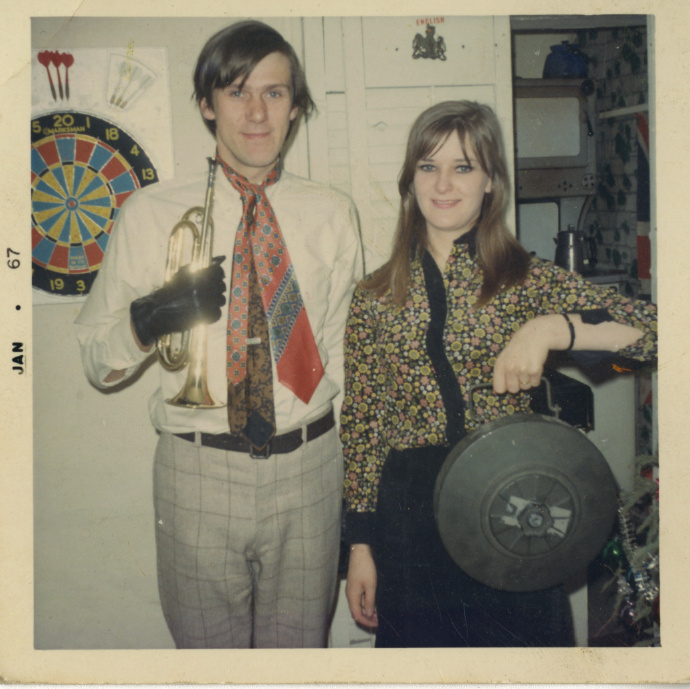
Young Pat Haggins and her husband when they wrote “Hen Rose Goes for a Walk”
Can you guess what she was holding in her left hand when she took the photo? (Hint: a weapon)
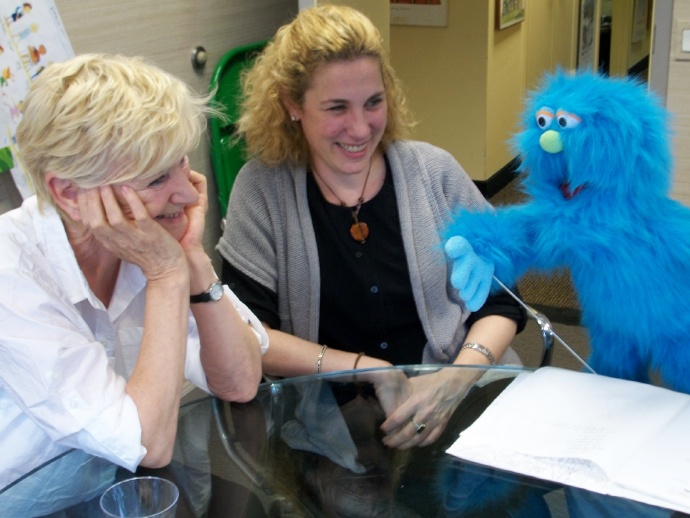
Recent photo of Pat Haggins (the woman on the left)
Indeed, what makes “Hen Rose Goes for a Walk” a paragon of picture book narrative is that it leaves as much of the storytelling as possible to the pictures, leaving only the seemingly dry, bare bones of the text. The most vivid story unfolds within the pictures, creating a powerful tension between the text and the pictures. Readers young and old, reading together, develop a kind of complicity, deliberately leaving out the stories of characters other than Hen Rose, only to burst into laughter by the end.
The success of Hen Rose made Pater and Susan become close friends. Pater returned to London to settle down after 1968, but most of the American copyrights of her subsequent works were entrusted to Susan. When Susan left Macmillan in 1974 and founded her own Green Willow Book Company, Pater continued to sign a contract with Green Willow until today, which shows the depth of their trust.
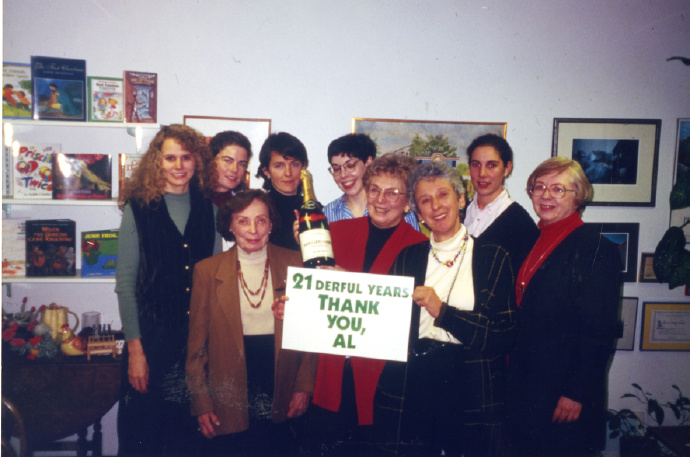
Susan Hirschman (woman holding the sign) and colleagues celebrate Green Willow’s 21st anniversary
Let’s talk about another Anne, whose full name is Anne McNeill. She is a publisher at Hodder Children’s Books in the UK. Anne has been working in the UK publishing industry for many years and is a rare veteran editor who still retains a passion for children’s books. She said that she might not remember the contents of her refrigerator, but she can recite the words of a picture book she read 20 years ago. It was perhaps this passion and creativity that ignited Pat Haggins. Pat said that people had suggested writing a sequel to Hen Rose from time to time, but it wasn’t until she met Anne that her inspiration was truly sparked.
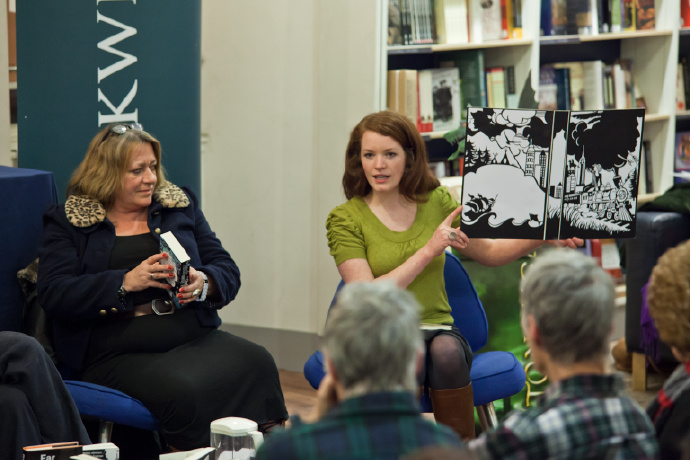
The person on the left is editor Anne McNeill
Then Rose the hen really came back, and we were blessed.
Written in Beijing on September 15, 2015
